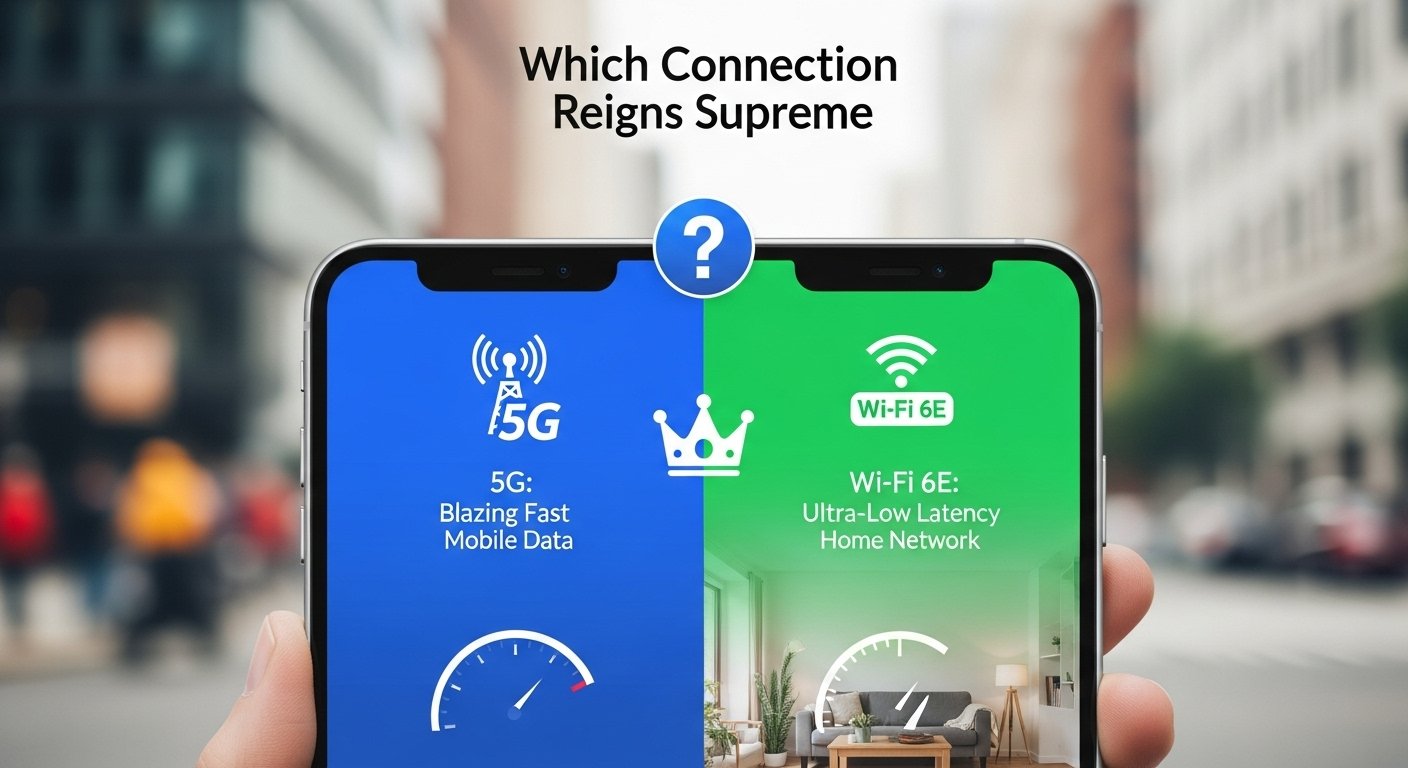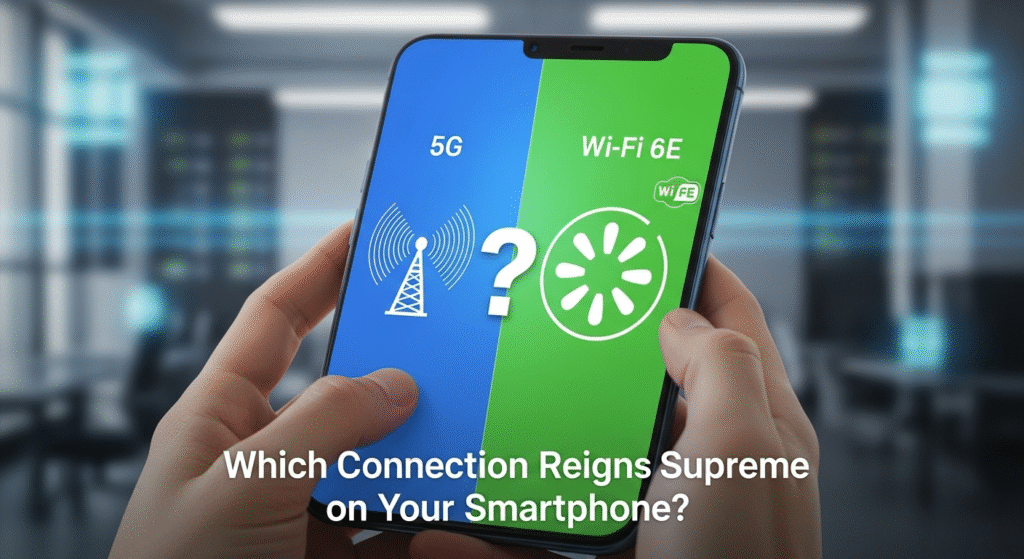Okay, let’s be real. We’re all glued to our smartphones, right? Scrolling, streaming, gaming – it’s basically an extension of our hands at this point. And the thing that makes all that magic happen? The connection. But lately, it feels like there are so many options. 5G this, Wi-Fi 6E that… it’s enough to make your head spin. Honestly, sometimes I feel like I need a PhD just to understand what’s going on. So, which connection is actually better for your phone? Let’s dive in, shall we? (Spoiler alert: it’s not always a clear-cut answer.)
Understanding the Contenders: 5G and Wi-Fi 6E Basics

First things first, let’s break down what we’re even talking about. 5G, the fifth generation of wireless technology, is the successor to 4G LTE. It promises faster speeds, lower latency (that annoying lag when you’re gaming), and more bandwidth for all those connected devices we’re accumulating. Think of it as a superhighway for data.
Wi-Fi 6E, on the other hand, is the latest version of Wi-Fi. The ‘E’ stands for ‘Extended,’ because it uses the 6 GHz band, which is less congested than the 2.4 GHz and 5 GHz bands used by older Wi-Fi versions. More bandwidth, less interference, happy days! In theory, anyway.
But here’s the thing: they aren’t exactly direct competitors, not really. They work in different ways, and excel in different situations. It’s like comparing a sports car to a pickup truck. Both get you from point A to point B, but their strengths are vastly different.
Speed Demons: Is 5G Really Faster Than Wi-Fi 6E?
This is where things get a little… murky. On paper, 5G can be faster. We’re talking potential gigabit speeds, which is seriously impressive. But the real-world experience? It’s highly variable. 5G speeds depend heavily on factors like network congestion, distance from the cell tower, and even the type of 5G technology being used (mmWave vs. Sub-6 GHz – don’t even get me started!). During my five years working with this technology, I realized this, it is not that straight forward as they say on the news. The frustrating thing about this topic is that providers give a range that is mostly not reachable.
Wi-Fi 6E, however, offers more consistent speeds, especially if you’re close to the router and have a relatively uncongested network. The 6 GHz band is a game-changer in that regard. I initially thought that 5G would obliterate Wi-Fi 6E in terms of speed, but after looking deeper, it’s clear that Wi-Fi 6E can often hold its own – and sometimes even win. Crazy Games requires the best connection speed while playing games.
Coverage and Availability: Where Can You Actually Use It?
Ah, coverage. The Achilles’ heel of 5G, at least for now. While 5G is expanding rapidly, it’s still not available everywhere. You might have blazing-fast speeds in the city center, but as soon as you venture out to more rural areas, you’re often back to 4G LTE (or even worse, gasp!).
Wi-Fi 6E, on the other hand, is limited by the range of your router. You’re generally stuck within your home or office network. But here’s the thing: most of us spend a lot of time within range of Wi-Fi. Think about it: home, work, coffee shops, libraries… Wi-Fi is pretty ubiquitous. This makes political discussions at our home possible, with everyone checking different sources.
But – and this is a big but – Wi-Fi 6E requires a Wi-Fi 6E-compatible router and a Wi-Fi 6E-compatible device (like your smartphone). So, you might need to upgrade your equipment to take full advantage of it.
Battery Life and Data Caps: The Hidden Costs
Let’s not forget about battery life! 5G can be a real power hog, especially if you’re constantly searching for a strong signal. That blazing-fast speed comes at a price, and that price is often your phone’s battery draining faster than you’d like.
Wi-Fi, generally, is much more energy-efficient. It’s a more stable and consistent connection, which means your phone doesn’t have to work as hard to maintain it. Plus, with Wi-Fi, you’re usually not subject to data caps (unless your internet provider is particularly stingy). With 5G, you might find yourself carefully monitoring your data usage to avoid overage charges. And no one wants that.
Think about it this way: streaming a movie over Wi-Fi at home? No problem. Streaming that same movie over 5G while you’re on the go? Suddenly, you’re thinking about your data plan.
5G vs. Wi-Fi 6E: Which Connection Reigns Supreme on Your Smartphone? FAQs
How do I know if my phone supports 5G or Wi-Fi 6E?
The easiest way to check is to look at your phone’s specifications. You can usually find this information on the manufacturer’s website (like Samsung, Apple, or Google) or in your phone’s settings menu. Look for terms like “5G,” “Wi-Fi 6,” or “Wi-Fi 6E.” Keep in mind that even if your phone supports these technologies, you’ll also need a compatible plan or router to actually use them.
Will 5G eventually replace Wi-Fi?
That’s a question I get asked a lot, and honestly, I don’t think so. While 5G is definitely a game-changer for mobile connectivity, Wi-Fi still has a crucial role to play, especially indoors and in areas with high device density. I see them more as complementary technologies rather than direct replacements. They both serve different needs and excel in different scenarios. Besides, market data would be difficult to obtain if WiFi was to go out of circulation.
My 5G is slow. Is there something wrong?
Potentially, yes. There are a few things that could be causing slow 5G speeds. Network congestion is a big one – if a lot of people are using the network in your area, speeds can slow down. Distance from the cell tower is another factor. Obstructions like buildings or trees can also interfere with the signal. And of course, it’s always worth checking your data plan to make sure you haven’t exceeded your data limit.
How does Wi-Fi 6E improve my smartphone’s connection?
Wi-Fi 6E’s biggest advantage is the use of the 6 GHz band. This band is less crowded than the 2.4 GHz and 5 GHz bands, which means less interference and faster speeds. Think of it as adding more lanes to a highway – more traffic can flow freely. This is especially noticeable in crowded environments like apartment buildings or offices, where there are usually a lot of Wi-Fi networks competing for bandwidth. The 5G vs. Wi-Fi 6E debate often overlooks this crucial point.
So, there you have it. 5G and Wi-Fi 6E: two contenders vying for your smartphone’s connection supremacy. The truth? There’s no single winner. It depends on your individual needs, your location, and your usage patterns. But hopefully, this has helped you understand the pros and cons of each technology so you can make the best choice for you.



